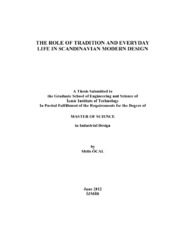Please use this identifier to cite or link to this item:
https://hdl.handle.net/11147/3550Full metadata record
| DC Field | Value | Language |
|---|---|---|
| dc.contributor.advisor | Talu, Nilüfer | en |
| dc.contributor.author | Öcal, Melis | - |
| dc.date.accessioned | 2014-07-22T13:51:47Z | - |
| dc.date.available | 2014-07-22T13:51:47Z | - |
| dc.date.issued | 2012 | en |
| dc.identifier.uri | http://hdl.handle.net/11147/3550 | - |
| dc.description | Thesis (Master)--Izmir Institute of Technology, Industrial Design, Izmir, 2012 | en |
| dc.description | Includes bibliographical references (leaves: 77-81) | en |
| dc.description | Text in English; Abstract: Turkish and English | en |
| dc.description | xi, 103 leaves | en |
| dc.description | Full text release delayed at author's request until 2015.10.08 | en |
| dc.description.abstract | Within Modernization, Modern design always rejected tradition and past and also focused on austerity and functionality. Modern design has always been criticized for being separated from nature and everyday life. Modern design has always been considered as being an alienated product of industrial production mode. However, Scandinavian design, Northern Europe design approach, has been distinguished in integrating their tradition and cultural identity into their design perspective which also embraces functionality. Additionally, Scandinavian design has been shaped as an integral part of their everyday life styles along with environmental factors. Their approach has been improved or influenced by the farm workers and fishermen who produced their own furniture using materials such as wood from the forest especially pine and spruce. They used cotton, linen, wool, sheepskin and furs for domestic textiles. They used palettes as light and pallid in contrast to the Mediterranean countries. They used vivid patterns inspired by the nature to create comfortable and warm atmosphere. Thus, the result was differentiated in Modern design in its own broadest definition. This study argues that Scandinavian modern design created its own style. It focuses on integrating its tradition into modern notion, and also relates it with the environmental factors, everyday life styles and nature. The study searches Scandinavian design which refers to the nature and embodies the nature as design along with emotions and colors. Sweden is chosen for the case study as a representative Scandinavian country. Key Words: Modernism, Modern Design, Scandinavian Design, Tradition, Traditional Motifs, Folk Art, Daily Life, Environmental Factors, Natural Materials, Color Schemas. | en |
| dc.language.iso | en | en_US |
| dc.publisher | Izmir Institute of Technology | en |
| dc.rights | info:eu-repo/semantics/openAccess | en_US |
| dc.subject.lcsh | Design--Scandinavia | en |
| dc.subject.lcsh | Design--Sweden | en |
| dc.subject.lcsh | Furniture, Neoclassical--Sweden | en |
| dc.subject.lcsh | Industrial design--Sweden | en |
| dc.subject.lcsh | Design--Environmental aspects | en |
| dc.title | The role of tradition and everday life in Scandinavian modern design | en_US |
| dc.type | Master Thesis | en_US |
| dc.institutionauthor | Öcal, Melis | - |
| dc.department | Thesis (Master)--İzmir Institute of Technology, Industrial Design | en_US |
| dc.relation.publicationcategory | Tez | en_US |
| item.languageiso639-1 | en | - |
| item.fulltext | With Fulltext | - |
| item.openairecristype | http://purl.org/coar/resource_type/c_18cf | - |
| item.openairetype | Master Thesis | - |
| item.grantfulltext | open | - |
| item.cerifentitytype | Publications | - |
| Appears in Collections: | Master Degree / Yüksek Lisans Tezleri Sürdürülebilir Yeşil Kampüs Koleksiyonu / Sustainable Green Campus Collection | |
Files in This Item:
| File | Description | Size | Format | |
|---|---|---|---|---|
| 445135.pdf | MasterThesis | 6.49 MB | Adobe PDF |  View/Open |
CORE Recommender
Page view(s)
372
checked on Jul 22, 2024
Download(s)
458
checked on Jul 22, 2024
Google ScholarTM
Check
Items in GCRIS Repository are protected by copyright, with all rights reserved, unless otherwise indicated.